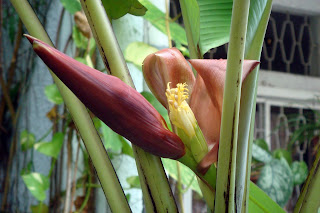 |
| Say 'goodnight'. — or 'goodbye'? |
Hi,
I was alarmed to learn recently that there may be no more cultivated bananas for us in 20 or 30 years!
Scientists are always coming up with such alarms. But lets look at what they are saying before dismissing them.
Wild bananas can be found in our forests! They are unpalatable and puny. They contain more seeds than the pulp that we eat. (The pulp is the placenta to which the seeds are attached.)
Due to man discovering a seedless mutant in his forages thousands of years ago, he has been using the same plant to propagate seedless banana trees using the vegetative (asexual) reproductive method.
As all of you know, sexual method of reproduction is far more superior than asexual. It confers the offspring genetic variation. This means that the offspring are all different from their 2 parents and their siblings.(due to meiosis cell division during sex cell formation).
Being genetically different at every generation gives protection against pathogens. When new germs attack the plant, some of the offspring may contain enough genetic difference to be able to survive the onslaught to be able to live long enough to pass on their genes to the next generation (aka reproduction).
But why did the farmers domesticate the seedless variety over the seeded ones?
It is so much easier to grow banana plants from suckers. It takes a shorter time for the plant to grow and bear fruit. He is assured of the quality, i.e. the bananas produced by the offspring will be 100% carbon copies in terms of taste, colour, shape, size and angle of curvature etc. Being able to predict these parameters is useful if you are growing bananas for a living.
 |  |
| A flowering domesticated banana plant | The banana flower head beginning to open |
 | |
| The flowers and immature banana fruit within the bracts of the flower head | |
Compare these images of a domestic banana with its wild cousin below. What differences strike you?
Due to the over-reliance of commercial growers on one sterile variety, a disease is sweeping the banana producing countries that is devastating crops.
You can read the article forecasting the demise of the banana to get further details here: 'Why bananas are a parable for our times'.
It is not likely that we will lose the bananas in our forests (so long as there are forests...) but it would take a long time to cultivate new edible varieties. Cultivation from suckers is ok so long as we maintain some diversity. Otherwise we risk slipping very badly on a banana skin.
Cheers
Below, a plantain squirrel feeds on an ornamental banana flower













nike kyrie 5
ReplyDeletegoyard
golden goose outlet
nike air max
air max 2018
hermes belt
golden goose
kobe 9
adidas stan smith
cheap jordans